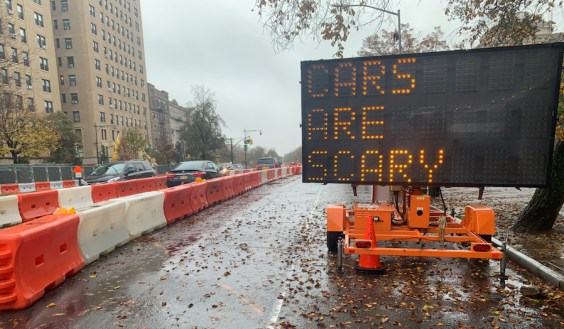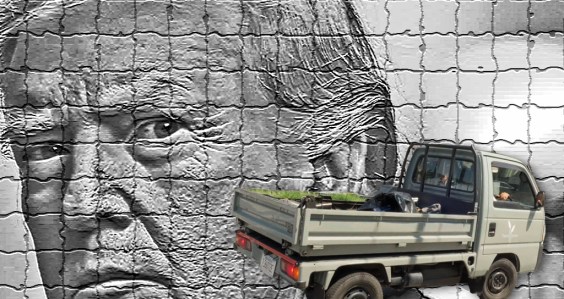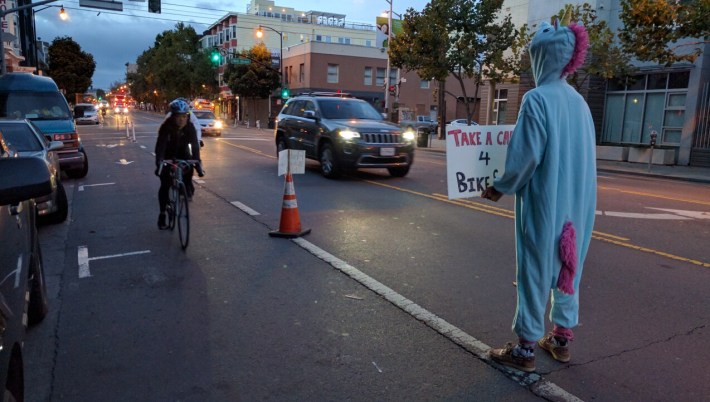
Streetsblog was up before dawn this morning, an invited guest of SFMTrA--the guerrilla group that's given up waiting for the city to make our streets safer--for a quick infrastructure upgrade to Valencia Street's bike lanes.
This time three members of the group, who go by the handles Copenhagen, Dragon (who came with a furry dragon suit), and Cone Guy, glued down 11 safe-hit posts on a stretch of Valencia from 17th to 14th, on the north bound side of the street. "We did a busy right-hand turn, where we felt it would do the most good," said Cone Guy.
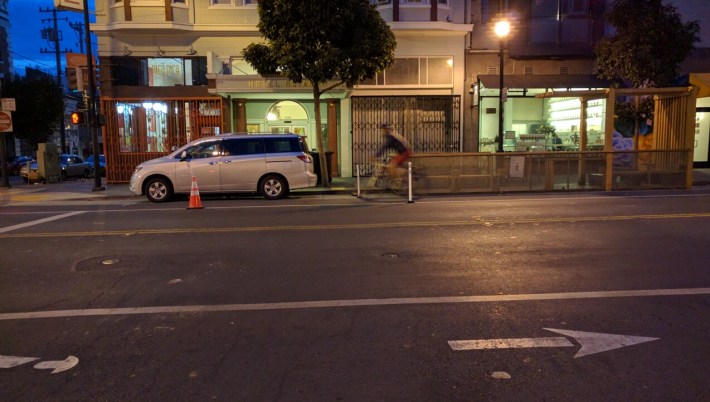
The group arrived at 6:30 a.m., and glued down the safe-hit posts, which are attached to the pavement with butyl adhesive pads, in less than 30 minutes. Streetsblog reported in a previous post on their efforts in Golden Gate Park. This time, given the traffic flows on Valencia, they decided it wasn't practical to press the pads down with a car tire, so a few stomps had to do. They were joined later by another guerrilla, handle of Olé, who helped hand out information cards. They also dropped down a few traffic cones, which they noted are "surprisingly heavy."
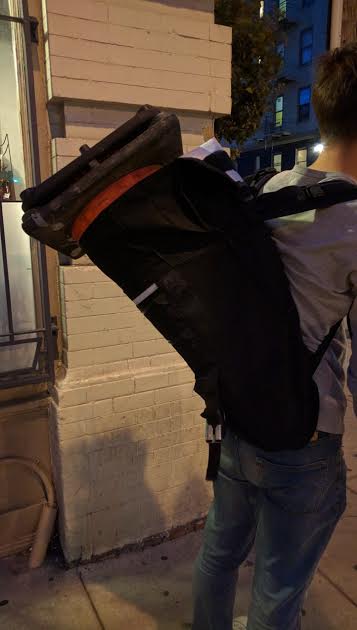
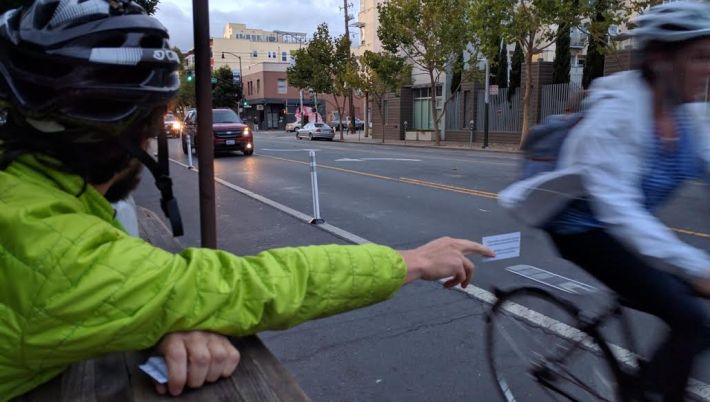
All told, the guerrilla installation cost about $300, with the safe-hit posts running about $30 a pop, which is well within their $8,000 budget, all raised from individual donations.

Meanwhile, from what Streetsblog observed, not only was the installation simple, intuitive, and easy to set up, but it seemed to be working. As in the photo of the garbage truck below, the posts forced cars to slow significantly when turning onto Valencia, preventing the kind of fast, sweeping, right-hook style turns that sometimes get cyclists killed or severely injured.
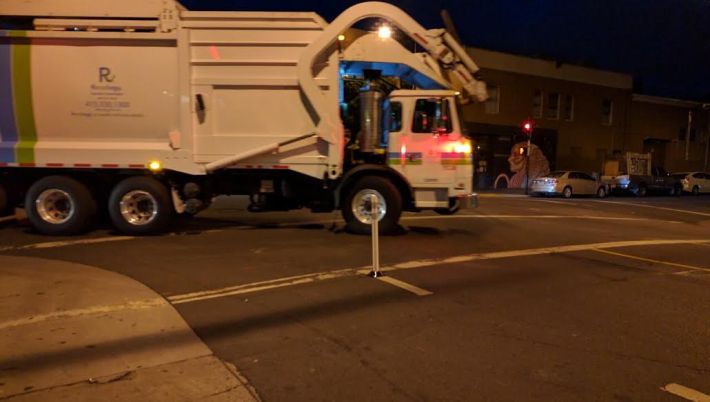
Deliveries seem to go more smoothly as well. Presumably because it was deprived of its usual loading zone (aka, the bike lane), a truck stopped in the median lane in front of Four Barrel Coffee to drop off some wonderful-smelling croissants. Not ideal, perhaps, but better than endangering cyclists by parking in the bike lane. "You see, there is space here to make loading zones," said Copenhagen. "It's not designed for it, but there's space."
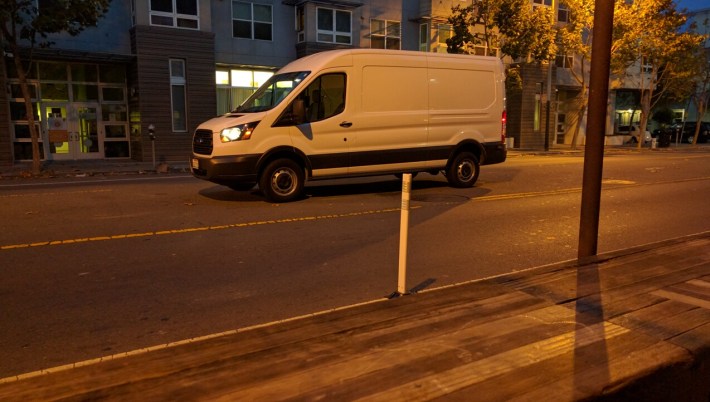
And what about our notorious ride-hail services, constantly blocking the bike lanes? Streetsblog observed a few. One drove past the safe hit posts and blocked the lane towards 14th street. The solution to that is simple--add more safe hit posts. (The SFMTrA crew and Streetsblog asked the rider to give the Lyft driver a bad rating, which she agreed to do.) Another ride-hail taxi partially blocked the lane between the posts, just south of 15th, but left room for cyclists to pass, possibly because the sight of the safe hit posts reinforced the presence of the bike lane? Several other cars discharged passengers while stopped at red lights or by pulling over legally, something rarely observed the last time Streetsblog joined bicycle advocates for a survey of Valencia.
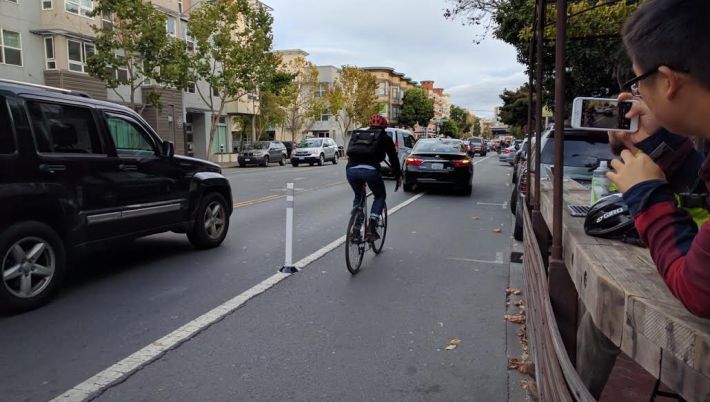
Okay. So why can't SFMTA, with their enormous resources, improve Valencia and other streets this fast and cheaply? This is a question that's been asked repeatedly, both by advocates and elected officials. To Streetsblog's view, it's never been satisfactorily answered.
SFMTA has also made it clear that in many cases, they will pull the un-official posts out as, indeed, they did to an SFMTrA installation on Folsom, reported Cone Guy. SFMTA's policy is to pull up posts that are placed on a single line (rather than a buffered space like on JFK drive in Golden Gate Park) because they can get knocked into traffic and bike lanes. But as the guerrillas have said in past reports, they consider that a "theoretical" concern--which doesn't amount to much, considering how many cyclists have died and been injured in San Francisco because of the failure of current, non-theoretical infrastructure. And, as Streetsblog has to add--they're called "safe-hit posts" because they're flexible and safe to hit.
How long can this cat-and-mouse game go on, with SFMTrA flirting with the law and putting down safe-hit posts, and SFMTA selectively pulling them back up? Who knows? But the SFMTrA crew has an advantage. "80 percent of the time we don't say where they are," said Cone Guy. "There are 500 miles of streets in San Francisco and SFMTA doesn't know where their own safe-hit posts are." And while they will continue to notify the press for the occasional high-visibility installation, much of the work they do goes unnoticed--except by thankful cyclists, who send the SFMTrA money.
This morning, meanwhile, SFMTrA volunteers stood by the newly post-protected bike lanes, handing out cards with renderings on them about what they'd really like to do if they had the resources of the real SFMTA. And that would mean using the same safe-hit posts, plus paint, to create a simple parking-protected bike lane on Valencia, complete with loading zones to meet the needs of businesses along the route. The cards have a simple instruction: "#DemandMore cyclist and pedestrian safety infrastructure from the SFMTA." They also say "Follow @SFMTrA and visit SFMTrA.org to learn more or get involved."
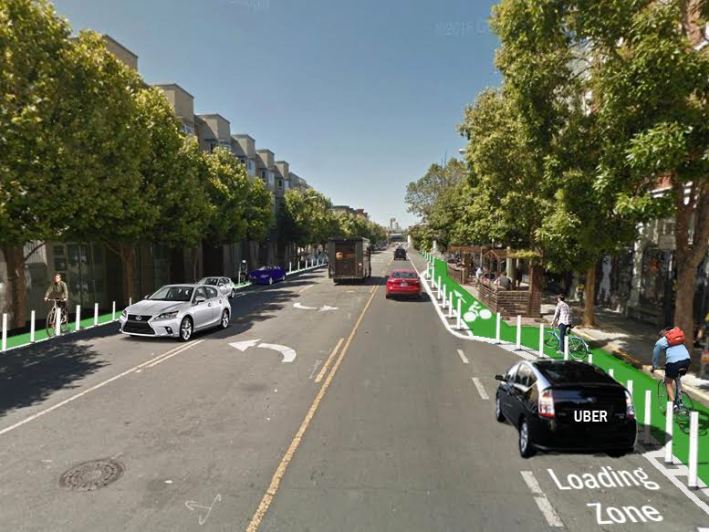
It's worth noting again that the SFMTrA was formed after the deaths of Kate Slattery and Heather Miller. Their hope is by showing how simple it is to install temporary, basic safety improvements, the SFMTA will be embarrassed into creating swift, ninja safety teams to take over. These guerrillas have day jobs to do and would prefer to skip the pre-dawn safety raids.
But until then, the volunteers are tried of going through channels and showing up at official meetings and demanding change, but seeing very little. Most of all, they're tired of seeing people die. "SFMTA is like being in a bad relationship with a passive-aggressive partner," said Olé, in between handing out information cards. "It shouldn't be this hard."
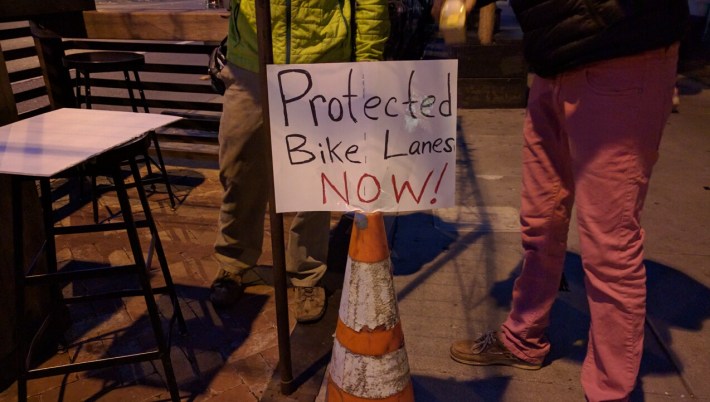
Want to support SFMTrA's work? Here's how.


